Intel Core i9-13900K and i5-13600K Review: Raptor Lake Brings More Bite
by Gavin Bonshor on October 20, 2022 9:00 AM ESTCPU Benchmark Performance: Power And Office
Our previous sets of ‘office’ benchmarks have often been a mix of science and synthetics, so this time we wanted to keep our office section purely on real-world performance. We've also incorporated our power testing into this section too.
The biggest update to our Office-focused tests for 2023 and beyond include UL's Procyon software, which is the successor to PCMark. Procyon benchmarks office performance using Microsoft Office applications, as well as Adobe's Photoshop/Lightroom photo editing software, and Adobe Premier Pro's video editing capabilities. Due to issues with UL Procyon and the video editing test, we haven't been able to properly run these, but once we identify a fix with UL, we will re-test each chip.
We are using DDR5 memory on the Core i9-13900K, the Core i5-13600K, the Ryzen 9 7950X, and Ryzen 5 7600X, as well as Intel's 12th Gen (Alder Lake) processors at the following settings:
- DDR5-5600B CL46 - Intel 13th Gen
- DDR5-5200 CL44 - Ryzen 7000
- DDR5-4800 (B) CL40 - Intel 12th Gen
All other CPUs such as Ryzen 5000 and 3000 were tested at the relevant JEDEC settings as per the processor's individual memory support with DDR4.
Power
The nature of reporting processor power consumption has become, in part, a bit of a nightmare. Historically the peak power consumption of a processor, as purchased, is given by its Thermal Design Power (TDP, or PL1). For many markets, such as embedded processors, that value of TDP still signifies the peak power consumption. For the processors we test at AnandTech, either desktop, notebook, or enterprise, this is not always the case.
Modern high-performance processors implement a feature called Turbo. This allows, usually for a limited time, a processor to go beyond its rated frequency. Exactly how far the processor goes depends on a few factors, such as the Turbo Power Limit (PL2), whether the peak frequency is hard coded, the thermals, and the power delivery. Turbo can sometimes be very aggressive, allowing power values 2.5x above the rated TDP.
AMD and Intel have different definitions for TDP that are, broadly speaking, applied the same. The difference comes from turbo modes, turbo limits, turbo budgets, and how the processors manage that power balance. These topics are 10000-12000 word articles in their own right, and we’ve got a few articles worth reading on the topic.
- Why Intel Processors Draw More Power Than Expected: TDP and Turbo Explained
- Talking TDP, Turbo and Overclocking: An Interview with Intel Fellow Guy Therien
- Reaching for Turbo: Aligning Perception with AMD’s Frequency Metrics
- Intel’s TDP Shenanigans Hurts Everyone
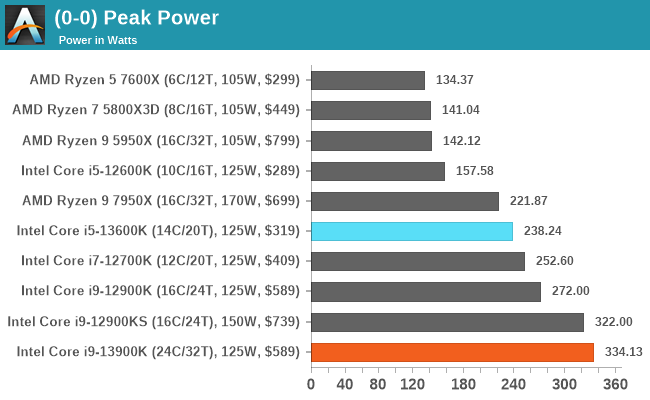
Directly digesting the peak power figures from both the Core i5-13600K and Core i9-13900K processors, the latter drew around 12 W more than the Core i9-12900KS does, and 62 W more than the regular Core i9-12900K. While additional power draw was to be expected due to the very high core clock speeds, let's not forget it is also a 24-core processor, hybrid cores or not.
Even so, the Core i9-13900K drew 32% more power than its 253 W Turbo PL2 limit, but it's very unlikely most users that are gaming or doing general PC stuff will ever see power figures like this. The key to note really with the Core i9-13900K is if it is using this power (125 W TDP to 253 W TDP = 2.02x the power) efficiently for the benefit of performance, then it makes it a less harsh pill to swallow. We would certainly recommend premium cooling with this for maximum performance efficiency.
Looking at the Core i5-13600K, this sits a bit higher than the AMD Ryzen 7950X in terms of peak power consumption, and just below the Core i7-12700K. The Core i5-13600K does draw considerably more power than its predecessor, the Core i5-12600K (157 W versus 238 W), but the increase in both core frequency and double the E-cores, is to be expected.
Looking deeper into the high power consumption of the Core i9-13900K, we can see that it is shooting above Intel's PL2 value considerably more than the previous generation. One potential reason for this is down to motherboard vendors continuing to ignore PL2 limits and optimizing for performance under a thermal limit as opposed to power.
During our testing of the AMD Ryzen 9 7950X, we saw our GIGABYTE X670E Aorus Master AM5 motherboard adhere to AMD’s PPT limit, yet with our MSI MPG Z790 Carbon WIFI, we are overshooting the 253 W PL1 limit by around 40-42% at peak figures. While we don’t believe that Intel is ignoring its own classification and specification of power limits here, we believe that the onus is on motherboard vendors to adhere to these limits. A lot of the time, motherboard manufacturers want to deliver the best possible performance out of the box it can, and while we don’t necessarily believe this is a massive negative, it does paint a picture that the Core i9-13900K has insane power draw at maximum load. A power draw that would otherwise be tempered significantly by adhering to PL2.
As we do some additional testing with the MSI MPG Z790 Carbon WIFI, we'll see if this is a specific problem with this particular motherboard, or if it’s the Z790 platform itself. We’ll also look to test some other LGA1700 models we have available, and we’ll update this analysis with our findings.
Office/Web
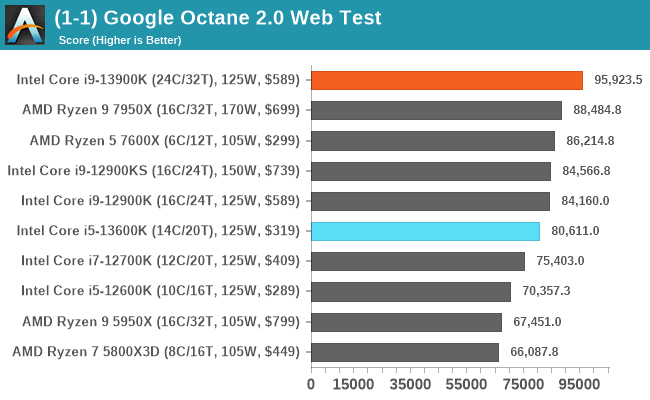
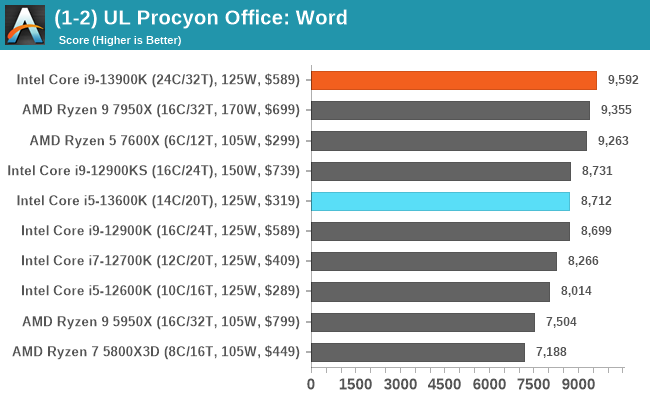
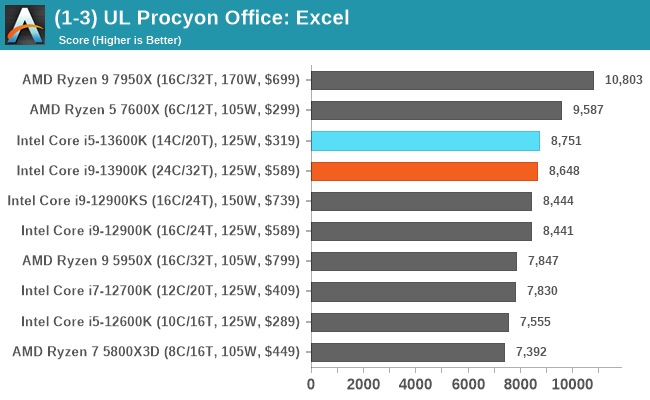
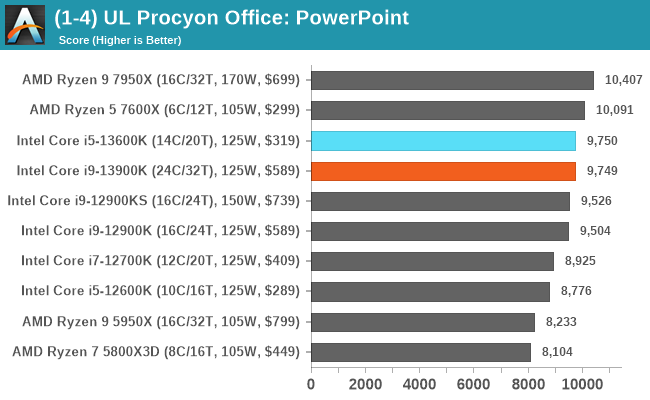

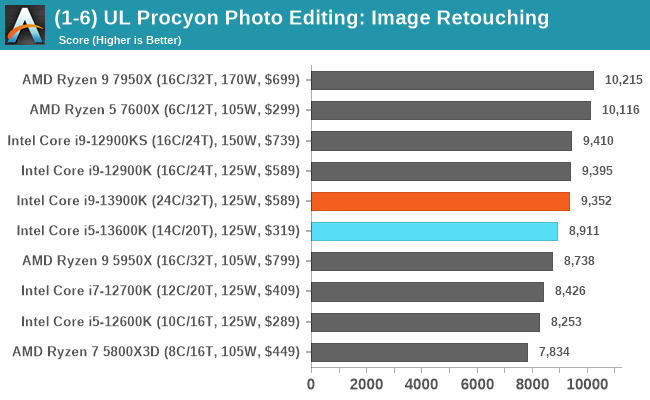
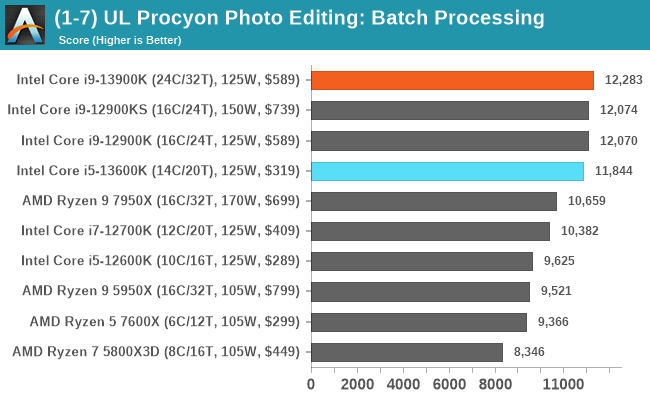
Looking at real-world web and office performance, the Core i9-13900K performs very well, and in a lot of tests, is neck and neck with the Ryzen 9 7950X. This is interesting given the Zen 4 is a new core on a new 5 nm process, and the Intel 13th Gen Core is a refined Intel 7 (10 nm) solution. The Core i5-13600K also performs competitively, and even the previous generation Core i9-12900KS are also in the thick of things.


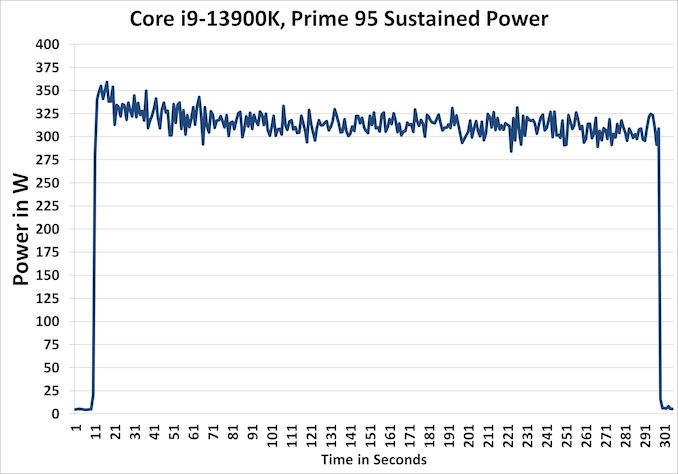








169 Comments
View All Comments
flyingpants265 - Thursday, October 20, 2022 - link
That doesn't matter. All that proves is TDP is a phony measurement. If the CPU draws up to 300 watts, then it's a 300 watt CPU. Replyyh125d - Friday, October 21, 2022 - link
Exactly ReplyIketh - Friday, October 21, 2022 - link
proving TDP is a phony measurement is the entire point of that post ReplyYojimbo - Friday, October 21, 2022 - link
Firstly this discussion is not confined to Intel. All the modern CPUs use turbo clocks. They all have various performance characteristics dependent on the thermal design of the product they are in.Please cite where Intel writes that. Intel only uses TDP in its technical literature these days for the very reason that consumers are confused about it. Intel uses PL1 and PL2. TDP is the MINIMUM power that one should be designing for, not the maximum. The amount of turbo clock exposed by the cooling solution is optional, but the thermal solution associated with the processor must be capable of handling the TDP. The processor will not be damaged with a cooling solution that only handles the TDP. The processor will not use its turbo clocks much and will stay at or below the TDP power except for short periods of time. On the other hand if a cooling solution cannot handle the TDP there could he bad consequences.
Again. This isn't an Intel-specific thing. TDP and turbo clocks are ubiquitous in the industry. What is also very widespread is massive misunderstanding and misinformation about the term. Perhaps Anandtech should stop using the term with respect to CPUs because it seems to me that it's a minority of readers who understand it. Reply
Meteor2 - Saturday, October 22, 2022 - link
Reviews should stop quoting TDP. Intel no longer uses it; their latest product spec pages e.g. for the i9-13900K quote Maximum Turbo Power: "The maximum sustained (>1s) power dissipation of the processor as limited by current and/or temperature controls. Instantaneous power may exceed Maximum Turbo Power for short durations (<=10ms). Note: Maximum Turbo Power is configurable by system vendor and can be system specific."Which for the i9-13100K is 253W. Reply
Meteor2 - Saturday, October 22, 2022 - link
AMD still quotes TDP (e.g. 170W for the 7950X) with no definition of TDP provided, which I would suggest IS misleading. Replyat_clucks - Monday, October 24, 2022 - link
Ah, not confined to Intel, solid argument that it's not a problem to do it but that "people are uneducated". Scale matters. When your real power consumption is 120% over the advertised one (see link below) this isn't an "everybody's doing it" but it is indeed a matter of "people are uneducated". At this time Jimbo, anyone trying to find excuses for Intel, and downplaying the shenanigans is _really_ uneducated, was born yesterday, or benefits from the lie.This doesn't mean you should stop using Intel if it does the job for you,. But only a fool or the fraudster would defend or downplay what they're doing.
https://images.anandtech.com/graphs/graph17585/130... Reply
catavalon21 - Sunday, November 20, 2022 - link
"Please cite where Intel writes that."Step right up, folks...
https://www.intel.com/content/www/us/en/support/ar... Reply
Truebilly - Friday, October 21, 2022 - link
🫳🎤 ReplyHarryVoyager - Friday, October 21, 2022 - link
Doesn't especially matter whether they are conforming to the technical definition or not as it is tells me nothing useful about the CPU in the context in which it is presented. Reply